This series is available as a PDF download at the bottom of the page.
It is common knowledge that a picture can say more than a thousand words, but is that also true in the technical environment, in production and in sales?
Where CAD data is available, everything seems to be said and done. “As soon as several variants of a product are possible, a visualization can be the decisive incentive to buy”, knows managing director Erich Schaarschmidt from numerous customer interactions. SAE has developed a unique standalone solution for variant configuration with 3D interactive visualization that is compatible with SAP ERP systems.
“In a nutshell, the big advantage is that the technical department is not burdened with additional work during the quotation phase, while sales and product management can independently generate 3D models,” says Susanne Henkel. CAD is and remains the heart of technical quotation. The data is not only complex, but also the intellectual property of the provider. By separating design knowledge, variant configuration and 3D visualization, SAE solves several problems with a single approach for the first time worldwide: CAD remains in design and production, while a digital twin is made available as an interactive, configurable 3D model to optimally support the sales process.
“The target audience for our solution are the sales team as well as a businesses‘ existing and potential customers. In short: companies that want to position their sales organization perfectly in a holistic and consistent manner,” says Susanne Henkel, defining the addressees of SAE‘s innovation. “With just a few clicks, sales staff can configure products that have been 100 percent tested for feasibility in design and production offline, online or on the web, while simultaneously generating a 3D interactive digital twin.” The sales representative can then generate an offer for his customer at the push of a button. Change requests are dealt with via automatic real-time changes to the 3D model including transfer to the ERP system (SAP ERP/ECC 6.0, S/4 and other ERPs).
In the E-3 interview, Susanne Heinkel adds, “Depending on the complexity of the offer, customers can independently configure their product or machine on e-commerce platforms, familiarize themselves with the product. The customer can even make a pre-selection that can be passed on to sales for sorting out the details to the specification in a second step.”
“CAD systems are used for technical product design, our system has been developed for holistic, visual, customer-specific product presentations”, explains Erich Schaarschmidt.
In practice, product development is specific to design groups. An overall portfolio of possible variations and accessories, which is important in the sales process, is usually missing or not necessary in classical product development. That is why Erich Schaarschmidt puts emphasis on how unique the interactive operating concept of the SAE Interactive Motion Engine really is. Without any knowledge in CAD, a sales representative can explain complex products in a transparent and comprehensible way for the customer. Interactive means: As soon as there is an interaction with an object in the digital twin, the user gets a visual indication of whether he can change the object, and if so, how. With the SAE Interactive Motion Engine, a sales employee is now simply able to change, customize and arrange complex machinery.
“Another advantage is the automatic integration of the SAE IME application into our sales documentation”, emphasizes Erich Schaarschmidt.
All selected and designed 3D objects are recorded as documentation items, so no option is at risk of being forgotten. The items then serve as the foundation for pricing and print control with corresponding text management. However, the innovation of SAP partner SAE does not stop at 3D visualization (with Virtual Reality). In combination with variant management and Configure Price Quote software, they bring together variant professionals and sales professionals, both in terms of business management and organization.
A recent study on product configuration as a success factor in mechanical and plant engineering , carried out by consulting firm Bearingpoint, comes to exactly the same conclusion: Although product configuration is increasingly seen as critical for corporate success, practical application remains opportunistic for the most part. That in turn means strategic sales potential remains largely untapped because of differing guiding principles: Variant professionals usually worry about how to configure a product, while sales professionals think about what to configure. Despite that, SAE has now succeeded for the first time in reconciling the two worlds by using the SAE Interactive Motion Engine based on a backoffice SAP ERP system.
Success factor product configuration
The results of the Bearingpoint study show, that 80 percent of industrial companies increasingly see product configuration as a success factor for their industrial business. On average, 58 percent of a company‘s products are configurable. Another 25 percent are planned and tailored specifically to customer requirements and only 17 percent are standardized. Companies however focus their product configuration more on technical possibilities and less on a clear sales and product strategy.
R&D is usually responsible for product models which thus are leaning towards being technically oriented correspondingly. That is the conclusion from Bearingpoint’s work so far. Already at this point, SAE follows a different philosophy. “Visualizing CAD data – that’s too limited of a scope for our innovation,” Susanne Henkel explains the alternative approach. “It is rather about bringing products and industrial plants to life.”
SAE Interactive Motion Engine is the only available application for creating digital twins. Size ratio and functionality become clear at a glance with the 3D visualization of the digital twin. Customers and interested parties can identify with the offered product within a few seconds. What is also new is that these 3D models can be moved freely and that the models are bound to the object dependencies of variant configuration. “The consistency achieved by combining these applications in one solution brings about enormous and significant benefits. SAE applications can be used independently and in symbiosis with SAP ECC or S/4,” emphasizes Susanne Henkel.
Customers and sales can make changes to specifications in the configuration and quotation process directly on the product or system – with the SAE Interactive Motion Engine, users can see the changes and results in real time and can move, (re-)position and execute functions in the digital twin. However, as Bearingpoint states in the current study, there is yet another factor to consider: The goals pursued in product configuration are largely operational, e.g. reducing errors in order processing in the sense of a feasibility check.
Strategic goals, such as increasing the Win-Rate or differentiated pricing, are hardly ever pursued by most participants. The possible potential for digitization remains largely untapped. There are no 3D previews of the product, nor are there product recommendations or suggestions for suitable options and packages by the configuration systems. The possibility of using an interactive digital twin to provide data from individual configuration right up to customer service (equipment information) also remains unused.
SAP partner SAE has now integrated all of this unused potential into a single solution and with the new software version, the system is ready for operational use. SAE has been in the business of customer-specific 3D representations, modeling and configuration of complex products in the worldwide sales process for more than twelve years,” explains Erich Schaarschmidt. “Our goal, or rather that of SAE customers, is that the further forward in the sales process we can present complex products in a customer-oriented manner, i.e. according to individual specifications, the more successful our customers are.
Most companies in the DACH region for instance use SAP and need applications that optimally support this powerful ERP solution. A requirement many years ago was to configure SAP’s variant configuration and material master (LO-VC) offline, while being able to adjust pricing in SAP down to the smallest detail. For some years now, the new challenge has been to be able to perform LO-VC on the web. SAE can do all this with its applications.
“Unfortunately, we often noticed that our customers are too slow through no fault of their own, that their systems are overloaded, that a customer’s change request ends up getting lost and that there are enormous processing costs involved. Therefore the change request is not welcome and thus processing times for offers are too long,” says Susanne Henkel about the situation more than ten years ago.
“That was the biggest question,” remembers SAE managing director Henkel in the E-3 interview. “How can we achieve a real competitive advantage and enable our customers to provide their sales team with an SAE application that allows them to easily configure their products in accordance with the predefined rule – based on the object knowledge with 100 percent LO-VC – with a few simple clicks in an appealing UI, on the web, offline or online with an automatic 3D representation of the product – from STEP files already available in the company? In a way that covers the entire process from product configuration based on object knowledge, quotation preparation, customer requests, versioning, technically sophisticated 3D interactive animation through to the printer position and all this can be carried out by the sales staff worldwide with just a few clicks.”
Today, a single sales employee with SAE software is able to configure technically complex products with a few clicks, SAP compatible and in an interactive 3D view, to show the individually configured product to the customer. At the same time, the employee can create an offer and hand over the order to SAP with one hundred percent feasibility for production and design, including lists of parts, prices, configuration evaluation etc. – and all of this on the web or offline. Does this new division of labor create new opportunities for sales due to the possibilities of the configurator? “Yes, definitely,” says Erich Schaarschmidt. “Globally operating sales teams can do their work simply, independently and largely without a back office – unlocking enormous potential. In symbiosis, e.g. with the SAP C4C CRM system, a unique solution is available for worldwide sales.”
Another very important side effect, explains Managing Director Schaarschmidt, is the learning experience, or rather the product training of new sales employees, who can very quickly build up product know-how with the SAE Interactive Motion Engine. “You see and then remember, which parts can be combined,” he emphasizes. The presentation, quality and above all, the certainty that the customer has really understood all the advantages of the product or complex solution in order to be able to make the right decision are considerably increased, which ultimately leads to more sales. Can everyone plan “everything” in the future or are there necessary limitations to this newfound freedom? “Every employee should be able to plan everything – within certain rules”, says Erich Schaarschmidt. “Our variant engine makes sure that there is no nonsense happening”.
How does that look in practice? To begin with, another quote from the aforementioned Bearingpoint study might be helpful: “In the majority of companies, an opportunistic use of product configuration is noticeable in total. It is used where operational processes have to be mapped. Once a sales strategy is affected, most companies become more cautious.” Is the market ready for the innovation of SAP partner SAE? To what extent are visualization and simulation in sales and service a matter of course? “Of course not yet,” says Erich Schaarschmidt,” but when people see how well and easily they can design and model such applications without outside help, they are all immediately enthusiastic and get to work!”
Megatrend Virtual Reality
VR is currently in very high demand in the videogaming scene. Can the SAE innovation therefore be part of this megatrend? SAE managing director Erich Schaarschmidt says that qualified young employees who are hired today, definitely no longer play with model railways. For the younger generations, an increasingly digitalized world around them is quite natural. “The advantage of digital objects is that we can experience them even though they do not yet exist in reality. The classic example is product development with 3D CAD systems – now standard for all of us. Our goal is to exploit new technologies in new processes with enormous potential for the entire value chain”.
However, according to the Bearingpoint study, this philosophy has not yet found a way into offices around the globe: “In the trend analysis, many companies plan to professionalize their product configuration by optimizing their IT architecture. The investment in configuration software, the integration of product data management systems and the provision of digital data to customers are key topics. The integration of the supply chain or the integration of product configuration in digital manufacturing structures (e.g. Industry 4.0) is seen as a trend only to a lesser extent. Digital trends such as Augmented Reality and VR solutions are generally not seen as relevant and will therefore continue to represent untapped digital potential in the future”. SAE has obviously managed to exploit this potential.
A digital twin in a few clicks
The world will change. “Design and product development are considerably relieved, since the creation and recurring changes to site plans and manual, customer-specific adjustments are not necessary anymore with the SAE solution. Adjustments in the sales phase are largely eliminated,” says Erich Schaarschmidt, recalling his experience from many successful projects. “The fact is that existing CAD files can be converted into an Interactive Motion Engine file format with a single click, so that configurations can be set up in a very short time with the SAE Developer. If configurations already exist – e.g. SAP LO-VC – a digital twin can be created on the web or offline with just a few clicks”, Susanne Henkel once again describes the potential in detail.
The Bearingpoint study also confirms that rigid viewers, films or 3D CAD images are a matter of course already. “What is new,” says Henkel, “and only the SAE Interactive Motion Engine can do, is that the different versions and configurations can be displayed directly in the interactive 3D model. It is very important to note however, that it is not only about the 3D representation of the products. Our solution is about the holistic, integrated approach to a global supply management system – whether offline or on the web.
As already mentioned, the SAE quotation management system allows the sales team to configure offers without the support of the technical department, to work out digital twins in 3D arrangement layouts and to make product changes in real time at the customer. “As a result, sales are self-sufficient, quotations are prepared more quickly and changes are made closer to the customer,” recalls Henkel from her practical work in the projects. Can the SAE offering be seen as part of a larger, digital transformation? “Absolutely,” Henkel replied quickly. “It is an absolutely novelty to provide the sales department with a complete solution with which they can configure products 100 percent rule-based and thus very quickly make offers, including customer-specific requests without requiring the support of their design or engineering colleagues.”
Digitally mapping products and technical know-how in the form of relational object knowledge is necessary in order to be able to successfully meet the requirements of global markets and be better than the competition in the future. “Topping an offer off with digital twins is the royal class and something really special at the moment – we believe it will become a matter of course in just five years’ time,” Henkel concludes.
Virtual Reality within the company
According to Goldman Sachs surveys, global sales in the Virtual/Augmented Reality market are projected to rise to 80 billion US dollars by 2025. Against this background, it is not surprising that many companies, from start-ups to publicly traded companies, define Virtual/Augmented Reality (VR/AR) as a strategic priority for the upcoming years. In fact, there are already meaningful and technically feasible applications and business opportunities in use in many industries. Pioneers and innovators have recognized this potential and are testing innovative fields of application. “The new emotional and communicative experiences are in the foreground”, Angelika Huber-Straßer, Divisional Director Corporates at KPMG, states in her introduction to the study on the potential of AR/VR in companies, entitled “New Dimensions of Reality”. Together with VR/AR specialist, the B2B area in particular was examined as early as 2016. According to KPMG, the market for VR/AR applications will develop very dynamically in the medium and long term, as complementary technologies will fuel far-reaching innovations. Additionally, in light of the digital transformation in the business sector, it can be assumed that players will initially have the optimization of the current value chain in mind. Moreover, according to the analysts, successful companies are already preparing for it today. Great potential (52 percent) was identified in marketing and sales in general and in sales support in particular.


















![visualization With 3D variant configuration, sales staff can provide customers with interactive offers for complex products. [shutterstock: 707776618, TierneyMJ]](https://e3zine.com/wp-content/uploads/2018/05/sae-interactive_motiong_engine_product-configuration_shutterstock_707776618web.jpg)


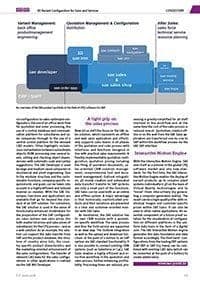
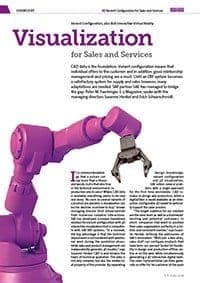
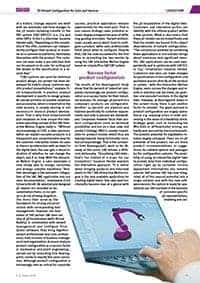
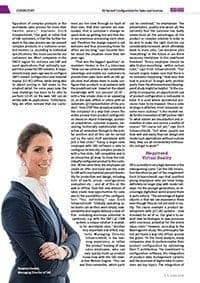
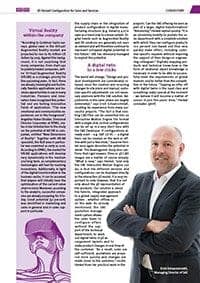
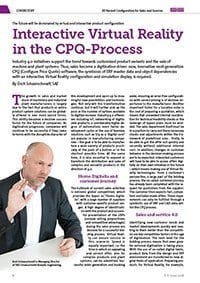
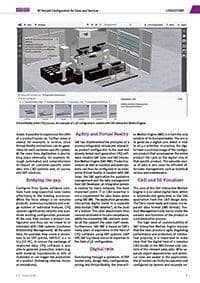
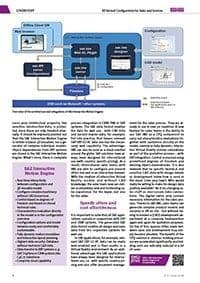
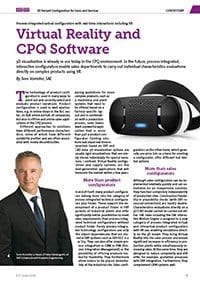


Add Comment